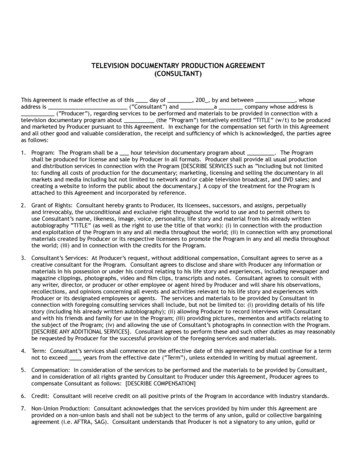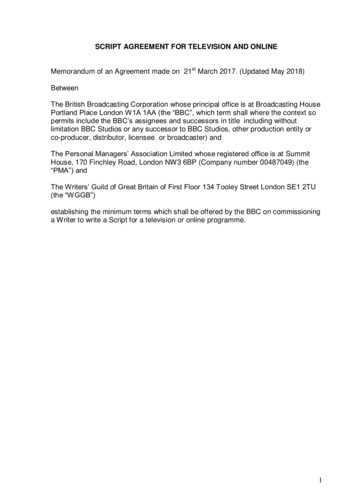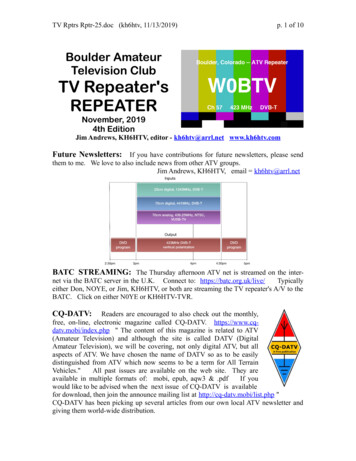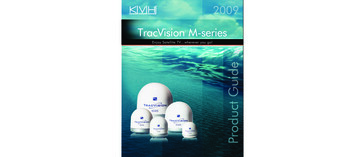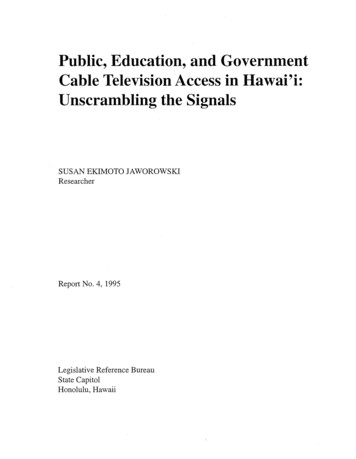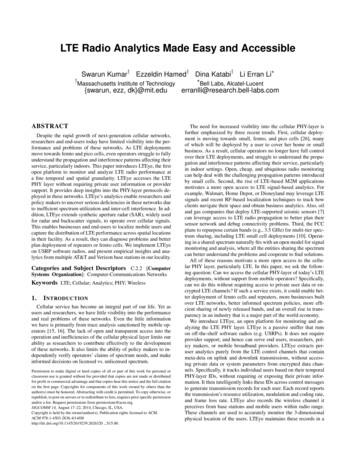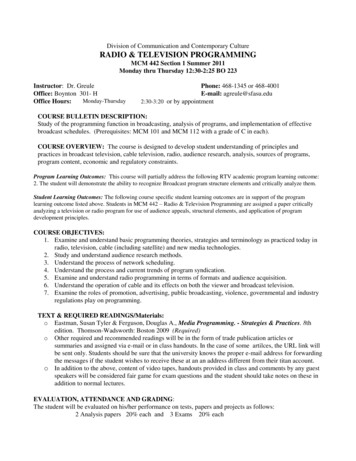
Transcription
Division of Communication and Contemporary CultureRADIO & TELEVISION PROGRAMMINGMCM 442 Section 1 Summer 2011Monday thru Thursday 12:30-2:25 BO 223Instructor: Dr. GreuleOffice: Boynton 301- HMonday-ThursdayOffice Hours:Phone: 468-1345 or 468-4001E-mail: agreule@sfasu.edu2:30-3:20 or by appointmentCOURSE BULLETIN DESCRIPTION:Study of the programming function in broadcasting, analysis of programs, and implementation of effectivebroadcast schedules. (Prerequisites: MCM 101 and MCM 112 with a grade of C in each).COURSE OVERVIEW: The course is designed to develop student understanding of principles andpractices in broadcast television, cable television, radio, audience research, analysis, sources of programs,program content, economic and regulatory constraints.Program Learning Outcomes: This course will partially address the following RTV academic program learning outcome:2. The student will demonstrate the ability to recognize Broadcast program structure elements and critically analyze them.Student Learning Outcomes: The following course specific student learning outcomes are in support of the programlearning outcome listed above. Students in MCM 442 – Radio & Television Programming are assigned a paper criticallyanalyzing a television or radio program for use of audience appeals, structural elements, and application of programdevelopment principles.COURSE OBJECTIVES:1. Examine and understand basic programming theories, strategies and terminology as practiced today inradio, television, cable (including satellite) and new media technologies.2. Study and understand audience research methods.3. Understand the process of network scheduling.4. Understand the process and current trends of program syndication.5. Examine and understand radio programming in terms of formats and audience acquisition.6. Understand the operation of cable and its effects on both the viewer and broadcast television.7. Examine the roles of promotion, advertising, public broadcasting, violence, governmental and industryregulations play on programming.TEXT & REQUIRED READINGS/Materials:o Eastman, Susan Tyler & Ferguson, Douglas A., Media Programming. - Strategies & Practices. 8thedition. Thomson-Wadsworth: Boston 2009 (Required)o Other required and recommended readings will be in the form of trade publication articles orsummaries and assigned via e-mail or in class handouts. In the case of some artilces, the URL link willbe sent only. Students should be sure that the university knows the proper e-mail address for forwardingthe messages if the student wishes to receive these at an an address different from their titan account.o In addition to the above, content of video tapes, handouts provided in class and comments by any guestspeakers will be considered fair game for exam questions and the student should take notes on these inaddition to normal lectures.EVALUATION, ATTENDANCE AND GRADING:The student will be evaluated on his/her performance on tests, papers and projects as follows:2 Analysis papers 20% each and 3 Exams 20% each
Final grades may be altered based upon the attendence policy (as outlined on page 3).The student will have the choice of completing any two of the three analysis assignments. The overallrules for paper submissions is on page 3.TV PROGRAMMING ANALYSISThe class will be presented with two programs that are new to the network schedule. Select one ofthose programs and analyze those elements of a program that we discussed early on in the course suchas writing, acting, character development, production, etc. Also discuss the elements that attempt tohold an audience such as packaging & sub-plots, opening tease, believability, audience appeals, etc. Inyour report, be sure to discuss the demographic appeal (and if the commercials matched that appealdemographically) and the other items discussed in both the class and in the text. Limit the report tothree pages double spaced and do not spend more than a half page on a synopsis of the plot and subplots.RADIO PROGRAMMING ANALYSISListen to a commercial radio station with a music format for one weekday drive time or mid-day hour.DO NOT choose a station for which you do or did work. Best choices would include a station thatplays the type of music that you like best so that you can identify and comment on the use of oldies,recurrents, new songs, etc. so that you can attempt to analyze the music rotation. Try to choose aformat that uses a personality rather than an announcer. Avoid off hours where the commercial level islow, as that will make it difficult for you to discuss the commercial demographics in relation to themusic appeal and the scheduling of spot breaks in the format. Include in your analysis the recordrotation, style of the personality, use of jingles, liners, ID's, teases, etc. Also discuss the treatment ofnews, contests, commercial clusters, demographic appeals and other appropriate observations. Includea run-down page where you list what was aired during the hour. Limit your analysis to no more than 3pages typed and double-spaced plus the run-down. Be sure to state what day and time you listened.WEB ANALYSIS PROJECTWeb sites are of increasing importance to broadcasters. Broadcasters have a tradition of reaching amass audience and communicating in a visual and/or audio medium but many are still learning whenit comes to programming the World Wide Web. The purpose of this assignment is to analyze theeffectiveness of web sites in terms of visitors to the website and in terms of cross promoting thestation and the web site. Can a station’s website stand by itself? Is it easy to use? What types of information does itprovide? Does it make the user want to watch or listen to the station? In what ways does it do this? Does it provide information for the viewer or listener if they want more info than what wasprovided by the broadcast? Can the website provide info to a listener or viewer who may have been unable to catch thebroadcast? Does it provide additional marketing opportunities for the station? Does the website stream audio or video or provide clips?Visit and analyze two radio and two television STATION websites. Examine them in terms of the abovequestions and in terms of the things discussed in class concerning website design and content. You maycompare and contrast the sites you examined for this report if it helps you make your explanations shorter andclearer. Limit your comments to a maximum of eight pages. Be sure to include the web addresses (URL) forthe sites.
All assignments are to be typewritten or word processed (that includes spell checked, etc.) and are due INCLASS on the due date. Any assignment turned in late WILL NOT be accepted and will not be given credit.Papers submitted on ANYTHING OTHER THAN WHITE PAPER WILL NOT BE ACCEPTED. Anyexceptions must be cleared by the instructor IN ADVANCE.Withheld Grades Semester Grades Policy (A-54)Ordinarily, at the discretion of the instructor of record and with the approval of the academic chair/director, a grade of WHwill be assigned only if the student cannot complete the course work because of unavoidable circumstances. Students mustcomplete the work within one calendar year from the end of the semester in which they receive a WH, or the gradeautomatically becomes an F. If students register for the same course in future terms the WH will automatically become an Fand will be counted as a repeated course for the purpose of computing the grade point average.ATTENDANCE & Conduct:Acceptable Student BehaviorClassroom behavior should not interfere with the instructor’s ability to conduct the class or the ability ofother students to learn from the instructional program (see the Student Conduct Code, policy D34.1). Unacceptable or disruptive behavior will not be tolerated. Students who disrupt the learningenvironment may be asked to leave class and may be subject to judicial, academic or other penalties. Thisprohibition applies to all instructional forums, including electronic, classroom, labs, discussion groups,field trips, etc. The instructor shall have full discretion over what behavior is appropriate/inappropriatein the classroom. Students who do not attend class regularly or who perform poorly on classprojects/exams may be referred to the Early Alert Program. This program provides students withrecommendations for resources or other assistance that is available to help SFA students succeed.Students coming into class late are disruptive and slow the process of covering material for those who were ontime. Therefore, lateness will count as an absence. The student should be aware that a departmentalattendance policy exists and should obtain a copy from the instructor or department office. THERE IS ONEDIFFERENCE IN THE INSTRUCTOR'S APPLICATION OF THIS POLICY: ABSENCES WILL BEEXCUSED ONLY IF PRESENTED TO THE INSTRUCTOR IN ADVANCE AND THE INSTRUCTORRESERVES THE RIGHT NOT TO ACCEPT AN EXCUSE. THE INSTRUCTOR WILL NOT ENTERTAINEXCUSES PRESENTED AFTER THE ABSENCE. Students should be ready to take notes at the start of classand Cell phones should be OFF. Vibrate settings and text messaging will not be tolerated. Anyone caught with acell phone in use will be considered not attending and will be given an absence as will anyone using a computerfor non-class purposes and/or talking with classmates. Food and drink in class is prohibited by UniversityPolicy (instructor will not enforce for bottled water w/cap). Visual or audio recoring of anyting in class withoutthe advanced consent of the instructor is prohibited.ACADEMIC DISHONSETY:Academic integrity is a responsibility of all university faculty and students. Faculty members promote academicintegrity in multiple ways including instruction on the components of academic honesty, as well as abiding byuniversity policy on penalties for cheating and plagiarism.Definition of Academic DishonestyAcademic dishonesty includes both cheating and plagiarism. Cheating includes but is not limited to (1) using orattempting to use unauthorized materials to aid in achieving a better grade on a component of a class; (2) thefalsification or invention of any information, including citations, on an assigned exercise; and/or (3) helping orattempting to help another in an act of cheating or plagiarism. Plagiarism is presenting the words or ideas ofanother person as if they were your own. Examples of plagiarism are (1) submitting an assignment as if it wereone's own work when, in fact, it is at least partly the work of another; (2) submitting a work that has beenpurchased or otherwise obtained from an Internet source or another source; and (3) incorporating the words or
ideas of an author into one's paper without giving the author due credit. Please read the complete policy athttp://www.sfasu.edu/policies/academic integrity.aspStudents with Disabilities: To obtain disability related accommodations, alternate formats and/or auxiliary aids,students with disabilities must contact the Office of Disability Services (ODS), Human Services Building, and Room 325,468-3004 / 468-1004 (TDD) as early as possible in the semester. Once verified, ODS will notify the course instructor andoutline the accommodation and/or auxiliary aids to be provided. Failure to request services in a timely manner may delayyour accommodations. For additional information, go to ED RESOURCES: All students will want to bring a calculator to class for the portion thatdeals with ratings and shares and the portion that deals with syndication.Other resources for this course that may be of interest to the student Broadcasting & Cable weekly trade publication TV WEEK weekly trade publication Brown, Les. Television: The Business Behind the Box. Harcourt, Brace, Jovanovich: New York 1971. Gitlin.Todd. Inside Prime Time. Pantheon: New York 1983. Norberg, Eric. Radio Programming: Tactics and Strategy:. Focal Press: Boston 1996. Arbitron website http://www.arbitron.com/home/content.stm Nielsen Media website http://nielsenmedia.comTENTATIVE LECTURE SCHEDULE AND DUE DATES:DATETopicT July 12Intro to course/Program elements/Program typesW July 13Dayparts/ PTAR/Network compensationTypesR July 14Audience flow theory/ Programming principles/ Network schedule/Reality ProgrammingDueCh. 1Ch. 4Ch. 5Affiliate programming & SyndicationProduction houses/Life cycle of programsAudience research-- Ratings/SharesAmortization/Independent stationsThe Rep/Group ownership/reviewExam l (Ch. 1-6 & materials covered)Ch. 6 & TV ProgrammingAnalysisogrammingTVProgrammingCh.2 & Ch. 3ProgrammingRatingsexerciseProgrammingM July 25T July 26W July 27R July 28Radio formats Dayparts /Record rotationsDuopolies/LMA's/ Networks and format suppliersMusic and audience researchPersonalities/promotion/indecency/Web pgm.Public Radio/Talk formats/News/SatelliteCh. 11Review p. 51-52Ch. 12 & p 46-47Radio AnalysisReview 64-68M Aug 1T Aug 2W Aug 3R Aug 4R Aug 4Exam 2 (Ch. 11-12 & materials covered) Webprogramming/Cable programming & networksPremium & pay cable/ Cable regulationsCable terms/Current cable issuesLAST DAY TO DROPReview 71-74Ch. 10Ch. 8 & p. 24-27Ch. 9 & Review Ch. 1&2M Aug 8Violence/ News programmingp. 174-184, 197-9M July 18T July 19W July 20R July 21
T Aug 9W Aug 10R Aug 11F Aug 12Public TV & CPB/ KidVid/promoTBACommercials/ReviewExam 3 at 12:30 PM (Ch 1, 7-10 & Materialsmaterials)Ch. 7 & review Ch. 2p. 47Web Site AnalysisCovered)Ratings/Shares/HUTs exercises:A program received a 7.8/14 in the national overnight ratings the other night. What is the HUT level ifthe universe is 114.7 million TVHH?If a market has 278,900 TVHH in the DMA and 19,523 of those watched “Frasier,” what is the ratingfor “Frasier?” If the HUT level is 162,692, what is the share?If Seinfeld is on at the same time with a share of 15, how many homes watched this program?If the Today show has a share of 25 and a rating of 3.2, how many TVHH watched the program if theuniverse is s
o Eastman, Susan Tyler & Ferguson, Douglas A., Media Programming. - Strategies & Practices. 8th edition. Thomson-Wadsworth: Boston 2009 (Required) o Other required and recommended readings will be in the form of trade publication articles or summaries and assigned via e-mail or in class handouts. In the case of some artilces, the URL link will be sent only. Students should be sure that the .

